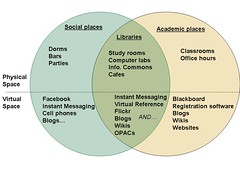This article is more than 5 years old.
For those who have been following the evolution of Library 2.0, a lot of this will be familiar… so I am just going to include links to most of what was covered:
- Tim Bucknall highlighted the OCLC findings
- Patrons want self-sufficiency, satisfaction, and seamlessness
- Danny Nanez highlighted Michael Habib’s Academic Library 2.0

- Discussed Blackboard, pathfinders, chat reference
- MyWelch: a blackboard interface for library services
- Students as creators of content
- Ann Arbor Library is innovative
- Ann Arbor Catalog
- University of Minnesota Website wiki is EXACTLY what we’re trying to do
- Gaming in Libraries (Amy Harris & Scott Rice)
- The idea is to make the library fun
- Overview of millennials (PDF)
- Discussed their game night, citing Giz & WFU; they include cards & board games
- Photos on Flickr
- Info Island on Second Life
- Another option, Active World, can link to web content, create floor plan of the library & link to real library resources
- UNCG Info Lit game, teaches info lit uses AJAX, is ADA compliant, and is free under CC License
- Tim Bucknall discussed the future of the ILS/OPAC, cited Roy Tennant presentation from SOLINET
- Federated search beyond just our catalog (journals, websites, etc)
- “Will ILS return to original function as inventory–rather than a search–tool?”
- Google Books (which I love, as you may know)
- Adding MARC records isn’t scalable when we have full text from all these major research libraries (via Google Books)
- People don’t want MARC records, they want to search full text
- Will probably turn to local data & inventory, where catalog is just a piece of search
- Says, “Why don’t we have a Digital Guilford where people can search local documents.” Sound familiar?
- Terry Brandsma discussed AquaBrowser as an enhancement to the catalog
- Examples of AquaBrowser: Queens Library & Arkansas State Library-Beebe
- AquaBrowser doesn’t require MARC records, could include journal articles, websites, etc
- Discussed Endeca as a more efficient catalog; developed for retail/business
- Examples of Endeca: NCSU & McMaster University
- Discussed WorldCat as way to search beyond just local holdings & searches across books and articles
- University of Washington is using WorldCat as their catalog
- Discussed SirsiDynix Enterprise Portal Solutions (EPS) as a way of forced clustering before searching
- Examples of EPS: Arcadia, Boston Public Library, & Cerritos College
- Discussed faceted and visual browsing including SirsiDynix & KartOO Visu
- Tim Bucknall and Lynda Kellam discussed Breaking Down Barriers
- Tim pointed out that libraries have traditionally tried to set itself apart from the internet & say “that’s bad, we’re good.” Now we’re realizing that users will be in that other space, & we need to put our content there.
- We can do this using: OpenURL, COinS (we have it, thanks to Kevin!), Bookmarklets, & Blackboard
- Pushing specific content to subject area classes in Blackboard
- Lynda demoed this content push to Blackboard; there is a “My Library Resources” option in the course
- Don’t have to reauthenticate once they’re in Blackboard
- Can also be pushed to open course websites (not necessarily Blackboard)
- Banner extract of classes is added to a library database, liaisons then can interact with databases & add appropriate resources to their courses
- Tim followed up on the Blackboard push project, they wanted to get down to just one click, so it required a different technology
- Want to use this technology in other ways: news, new resources, reminders, contact links, course guides, mobile, etc. Much more targeted!!
- Richard Cox worked on the technology behind this
- Tim answered questions: WebFeat was discussed… a little clunky/slower, limited searching, but is a big step forward from current EZ Search